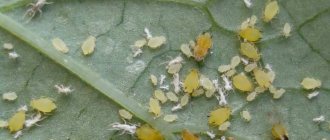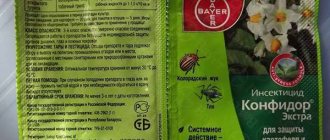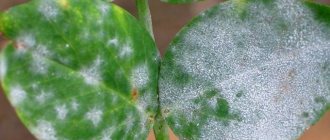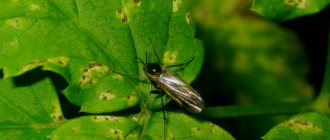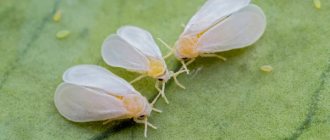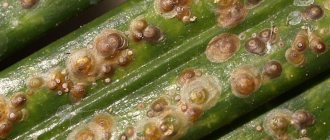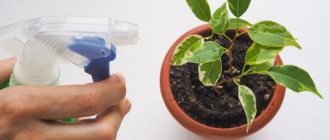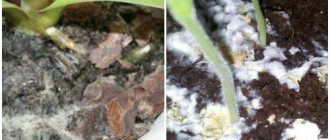- August 22, 2018
- Diseases and pests
- Legina Marina
If a sticky coating appears on your plants, then you need to immediately inspect the bottom of each leaf. The fact is that such symptoms very often indicate the presence of scale insects. Unlike most small pests, it is clearly visible on the surface of the leaf blade. It is the scale insect that is different in that it secretes a sticky liquid that seals the stomata and prevents the plant from breathing. At the same time, this film is an excellent breeding ground for fungi and bacteria. Today we’ll talk about what to do with scale insects on indoor plants and how to fight them. The photo will help you quickly identify this pest and select adequate control methods.
general description
What does this insect look like? This is a tiny creature that can destroy even a large tree. Its body is covered with a dense protective shell, so the scale insects can be mistaken for hard growths on the plant. It’s not for nothing that scale insects have a second name – garden turtle. But they are not at all as harmless as they might seem at first glance. In a couple of weeks, the voracious creatures will destroy any plant.
Every gardener should know well what scale insects look like on indoor plants and how to fight them. The photo shows us females up to 5 mm in length. They are the ones that are found motionless on plants and look like droplets of frozen resin. Males do not grow more than 3 mm and move freely around plants using legs or wings.
Description of the scale insect pest
It is classified as a member of the family of sucking pests - Pseudococcid. It can easily be confused with a false scale insect; its distinctive feature is the presence of a shell consisting of wax and completely hiding the body, which comes off without much difficulty.
Very active in all seasons. She is not picky about food, eats both garden and indoor plants and poisonous ones. If detected, you should immediately resort to means of disposal and preventive measures, otherwise the scale insect will settle well and it will be difficult to remove it.
Reason for appearance
In the garden everything is clear: young females and males fly freely and cover considerable distances. How does scale insect appear on indoor plants? How to fight? We will look at photos of effective drugs below, but for now we will look at ways of penetration into your home. This is usually soil, plant debris and water. And most often, parasites come to your house with new plants.
They usually begin to fight them when they appear en masse, without previously noticing them. Therefore, a new generation of scale insects spreads into neighboring pots. And only sudden, massive shedding of leaves, inhibition of growth or death of plants can become a signal for the owner that it is time to show maximum care.
Causes and signs of appearance
The main cause of scale insect infection is improper care and unsuitable conditions for keeping plants.
Where do pests come from?
Excess moisture or, conversely, insufficient water.- Lack of nutrients.
- Darkness (no sunlight).
- Dry air - the plant stops producing antibodies that provide protection against pests.
- Infected soil, infected new plants.
The most dangerous period for possible infection is winter , since at this time the composition of plant sap changes, it becomes ideal for feeding and rapid reproduction of parasites.
Symptoms of infection
At the initial stage, there are no obvious symptoms: the scale insect moves quickly and can be detected through a microscope. Adults of the pest appear as round brown scales where the leaf stalk meets the branch or trunk. As the parasite population increases, symptoms progress. The main one is sticky honeydew on the leaves, which flows onto the windowsill.
Threatened
Scale insects can appear on indoor plants no matter how well you care for them. Moreover, it affects any plant, including succulents. But this pest also has its favorites, which are attacked first. We are talking about orchids and laurels. Palm trees and ivy do not avoid scale insects. With great pleasure, the scale insect feasts on Cyperus, Aucuba and other exotics. The usual household inhabitants are also under attack: chlorophytums, geraniums and hippeastrums.
What is noteworthy is that the pest most often appears in winter and early spring. This is evidenced by numerous amateur photos. How to deal with scale insects on indoor plants? It is necessary to improve the immunity of the plantings. After all, at this time the plants are most weakened, which becomes a decisive factor for the pest. It is much easier for them to harm flowers that are not able to resist. Therefore, follow the recommended conditions, and closer to spring add special immunostimulants to the soil. This could be inexpensive succinic acid.
Preliminary activities
First of all, it is necessary to identify the source of infection of the flower garden - the plant on which the scale insects have settled.
On a note! It is quite difficult to determine where exactly they came from, since the eggs of these pests could be carried with the soil, or with new specimens, or even with the water that you used for irrigation.
The infected plant or plants should be isolated immediately. It is advisable to put them in a room where there are no flowers and only then begin treatment. It is necessary to take into account the fact that scale insects are usually most active in early spring and winter - during this period the flowers are weakened, as they are either recovering from winter “sleep” or are in a dormant stage.
Recommendation! For this reason, during the winter and early spring, it is necessary to inspect the plants more often, do not forget to fertilize them on time and sometimes moisten them with a spray bottle.
Damage caused
The larvae wait in the wings, feeding on cell sap. With severe damage, plants become covered with a coating of pest bodies, and it is almost impossible not to notice this. Autumn is coming in your home garden, the leaves are flying away.
The scale insect and its larvae can live and feed on indoor plants all year round, and the insects reproduce very quickly. They reproduce by laying eggs, which contributes to rapid population growth. At the initial stage, the larvae are very mobile, especially the males. But they live only a few days, and the female will feed and breed for several months.
What harm does it cause?
Most often affected:
- orchids;
- palm trees;
- ficus;
- citrus and tropical species.
But parasitic individuals of this species are able to live on different plants, and even poisonous ones. Scale insects settle in colonies and suck all the nutrients from the trunk or shoot . This leads to necrosis (death) of cells, and sometimes death of the flower.
The larvae can live without food for about two days until they find a suitable place to attach. They leave behind a sticky trail that can become a breeding ground for fungal diseases and bacteria. The main advantage of indoor pets – their decorative properties – are lost. If the damage is severe, the plant dies.
Do not confuse with false scale insects
This is another pest that appears very similar in appearance. These insects belong to the same order, but they are separated into a separate family. They differ from scale insects in that the latter do not have a waxy shell. Their eggs and larvae are protected by the dry skin of the dying female after laying. In the first stages, small insects move quickly, and this applies to both true and false scale insects. But if you see that a sticky patch begins to form on the leaves, there is no longer any doubt: this is what you are looking at.
How to distinguish scale insects from false scale insects?
Scale insects and false scale insects belong to different families - Diaspididae (pseudococcidae) and Coccidae, or Lecaniidae. It will be difficult to distinguish scale insects from false scale insects, since these families are diverse and similar.
SIMPLE WAY
To identify a pest with the naked eye, you need to try to take an insect. If the shield can be removed and a “booger” remains on the stem, then it is a scale insect, and if the insect is completely removed, then it is a false scale insect, since its shield is part of the body.
EXACT METHOD
The pest needs to be examined under a microscope. If eyes are visible on the shield, then it is a false scale insect, and if the insect’s eyes are in their usual place, then it is a scale insect.
There are other methods of determination, but they have a number of disadvantages and are less accurate. However, the essence is the same: in an adult scale insect, a shield is formed on top, and in a false scale insect, a shell resembling a shield is formed.
.
False shield
.
Preventive actions
Below we will talk about how to deal with scale insects on indoor plants, but for now let’s look at what can be done to prevent damage. The following measures will help protect your flowers:
- Constant control of the soil in plant pots. It must be of high quality and clean.
- Dead and weak shoots must be cut off in a timely manner. This will preserve the strength of the plant and prevent rotting. Be sure to disinfect the sections.
- Ventilate the room frequently and maintain the required air humidity.
- Quarantine all new plants for a month. A similar technique should be used when returning your plants from their summer residence in the garden, in the fresh air. There are quite a lot of chances to become infected with scale insects in the garden.
Preventive measures
Simple preventive measures will help prevent pest infestation or their reappearance.
- It is advisable to place the purchased seedling in “quarantine” for 2 weeks and not immediately place it with other plants.
- Indoor flowers need to be provided with suitable conditions: sufficient heat and light, moderate watering without overwatering.
- Fertilizer feeding.
- Regular care: inspection, removal of dead parts, washing.
- For preventive purposes, it is worth regularly spilling the soil with a weak solution of potassium permanganate. Treat pedestals, stands, and window sills with antiseptics.
Fighting methods
The more pests manage to multiply, the more difficult it will be to get rid of them, and the more severe the damage caused. And the first remedy for scale insects on indoor plants is to pick them from the leaves by hand. It should be noted that the fight against these creatures is long and very difficult. A durable shell reliably protects pests from any damage. Therefore, first of all, we examine the axils and leaves on both sides. A small flat growth is a pest. It must be carefully torn from the plant and destroyed. To make this task easier, you can use a toothbrush. This is only the first, but a very important step. Because by leaving pests on the stems, you give them a chance to reproduce.
Reproduction of the Decembrist
Schlumbergera stems are long shoots divided into segments. Propagation is carried out by cuttings, carefully separated from the main stem by unscrewing. Breeding time is spring, early June. The cuttings must be slightly dried (to prevent rotting), then placed in a container with a damp peat-sand mixture. Provide greenhouse conditions (cover with a transparent cap or jar), but do not forget to ventilate. Propagation by cuttings has a beneficial effect on the condition of the mother plant. Separation of segments stimulates the growth of new shoots and abundant flowering.
Hygiene measures
The fight against scale insects on indoor plants begins with treatment with a soap solution. Most pests cannot tolerate this. Moreover, both the placement of the pots and the vessels themselves will need to be treated. It is best to replace the soil by first calcining the fresh soil mixture.
To prepare a concentrated soap solution you will need 100 g of grated laundry soap and a liter of water. After complete dissolution, add 200 ml of kerosene. All this must be thoroughly mixed until a white foam forms. Before use, the mixture must be diluted in 10 liters of water. After wiping with this solution, the plant is given a warm shower a few hours later, after which it is placed in a warm place to dry. This is one of the gentlest remedies, but it can be quite effective. True, there is a chance that the larvae will survive and give birth again. For complete victory, 2 to 3 treatments may be required at intervals of 7 days. The fight against scale insects on indoor plants can be long and difficult, so let's look at more reliable means.
Basic treatment methods
The fight against the parasite is complex and step-by-step. Chemical control measures work against pests. Timely spraying of indoor flowers with pesticides is required.
How to get rid of false scale insects at home
Isolate the diseased plant. This will prevent further migration. Artificially increase the air humidity around the affected specimen. Achieved with improvised means: cover with a plastic bag, a jar, or build a mini-greenhouse. Ventilate once a day for 20-30 minutes.
Important! Plants that lived next to the infected one are carefully examined. Observe them for 2-3 weeks - this will reveal young, grown-up individuals.
Next steps:
• rinse the flower in warm water and dry;
• Collect mobile scale insects with sticky insect-catching plates. Change them daily, 1-2 weeks in a row, even if no insects are visible;
• treat with folk remedies. If there is a large concentration of colonies, use an insecticide.
Fight with special drugs
Insects hide well, it is important to get them out of their hiding places. Dangerous places are the axils of the lower leaves, dry skin on branches and trunks. Repeated treatment is required, according to the instructions for the drug. In severe cases, spraying is carried out 3-4 times.
Insecticides:
1. Contact - penetrate through the shield and destroy the parasite. Use against a small population background. You will process it in time, you won’t need to repeat the procedure. Do not leave the bush in direct sunlight, otherwise the leaves will turn yellow.
2. Intestinal – they destroy the insect by entering the body through the mouth.
3. Systemic - they enter the plant sap absorbed by the scale insect.
The last two types are designed to combat large concentrations of scale insects.
Aktar
Enteric contact pesticide based on thiamethoxam. The advantages are a low number of treatments, low consumption, preservation of the leaf apparatus. Translaminar action (through spraying) rapidly inhibits insect feeding.
Characteristics:
• proportion – 8 g/10 l;
• method – spraying of green mass. On plants with a height of 30-40 cm, repeated watering of the soil is carried out;
• frequency – 2 times at weekly intervals;
• result – complete death will occur within 24 hours;
Aktar works under high insolation, low humidity, and elevated air temperatures. Provides a long-lasting protective effect. Use against hidden scale insects that feed on the underside of the plates.
Fitoverm
Enteric contact insecticide. The active ingredient is aversectin.
Characteristics:
• proportion – 2 ml/250 ml;
• method – spraying;
• frequency – 2-4 with an interval of 7-10 days. Consumption 100 ml/sq.m.;
• result – complete death occurs on days 3-5.
Fitoverm is economical and demonstrates increased efficiency at high processing temperatures.
Peculiarity! Pay attention to chemistry based on paraffin oils (Promonal and analogues). It is applied pointwise to pest colonies. Cover too much surface and the plant will suffocate. But, the drugs are effective and cause the death of insects within the first day.
Traditional methods
So, we cleaned the plant from pests with a toothbrush, washed it with soapy water and dried it well. Now we consider further how to deal with scale insects on indoor plants using available means:
- Garlic solution gives good results. To do this, add 5 crushed cloves to a glass of water and leave in a dark place. After this, strain through cheesecloth and spray the plant with the solution. You need to carry out a number of treatments to get a good result.
- Pepper infusion. Another advantage is that the solution can be prepared for future use. To do this, boil 50 g of pepper for 5 minutes in 500 g of water. Let it sit for 24 hours and the infusion is ready.
- Celandine. Almost all pests cannot tolerate it. You will need to pour 300 g of dry celandine herb with a liter of boiling water. Leave for 24 hours, then spray the diseased plant.
- Oil film. Insects are living creatures that require air. To block its access, you can lubricate the affected areas with sunflower oil using a brush. The procedure is repeated every day until the insects completely disappear.
The effectiveness of folk remedies is quite difficult to assess. They are safe for humans, which is a big plus. But often gardeners are faced with the fact that the result is temporary and comparable to manual collection of pests. Within a few days, the larva hatches, and the surviving individuals lay new eggs. And now a new generation of pests is destroying your flowers. Of course, on a garden scale it is more difficult to deal with them. But if you have 3 - 5 pots at home, then you can check every leaf every day and not give the pest a single chance.
Struggle
If you find a scale insect on indoor plants, you should immediately take the first measures:
- Remove all twigs and leaves that the pest has managed to infect.
- If this is not possible, you will need to manually remove the insects using a cotton pad soaked in a soap solution or diluted insecticide. To remove woody shoots, you can use a knife, scraping off the parasites with the blunt side of the blade.
- Immediately isolate the sick specimen from neighbors and then carefully examine all the plants in the house. Preferably through a magnifying glass.
- Also treat the window sill and frame, shelving, and neighboring pots with a solution of insecticide or ordinary soap, because there may be eggs or larvae of scale insects on them.
- The top layer of soil must be immediately removed and replaced with a new one.
- Gently rinse the plant in the shower.
Now all that remains is to wait until the indoor flower dries. Then you can begin processing it using pesticides or folk remedies.
Chemicals
When all the moisture has evaporated from the leaves, it’s time to start processing the plant. Insecticides of chemical origin will help to completely destroy scale insects from indoor flowers. They show good results, but produce a toxic effect on the human body. Therefore, when working with chemicals you need to be extremely careful: follow the instructions exactly and do not neglect important safety precautions.
After treating the plant, the room must be well ventilated so that the insecticide vapors disappear.
Basic preparations for scale insects on indoor plants include Fitoverm and Aktara. They are easy to use and have performed remarkably well, becoming the favorite insecticides of many gardeners.
But sometimes their actions are not enough. And, if the treatment does not bring the desired result, more toxic drugs will come to the rescue:
- "Inta-Vir", "Konfidor", "Tanrek";
- "Aktellik", "Vermitek" and "Karbofos" are used if the scale insect infection has become widespread. Treatment with these agents can only be carried out outdoors, wearing gloves and a respirator.
Their list is given in order of increasing toxic properties.
"Fitoverm"
The drug has the mildest effects and is practically safe for humans. Therefore, experienced flower growers advise starting the fight against the pest with Fitoverma. To prepare the working solution, you will need to dilute 2 ml of the chemical in 200 ml of water. The plant is sprayed with this composition from all sides using a regular spray bottle. A total of 3-4 treatments will be needed to completely get rid of the pest.
"Aktara"
A powerful systemic insecticide that destroys most pests of indoor plants. A solution prepared at the rate of 1 g per 1.25 liters of water is suitable for spraying the green part. This volume is enough for 20-30 home flowers, depending on their size. “Aktara” also needs to be shed on the soil: for this, 1 g is diluted in 10 liters of water (standard bucket). As practice shows, 2-3 procedures are enough to eliminate the problem of pest infestation of indoor plants.
Scale insect larvae emerge from eggs gradually, so plants need to be treated until the pest is completely destroyed.
Rules for processing plants
In order for insecticides to work to their full potential, it will be useful to listen to the recommendations.
- The optimal average daily temperature for the use of insecticides is 22–24 °C. If the indicator is lower, the effectiveness of the remedy against scale insects will also decrease. This must be taken into account when planning the number of treatments.
- Some gardeners advise putting a plastic bag on the plant to enhance the effect.
- Each insecticide has individual application characteristics specified in the instructions.
- It will be useful to spray all the plants in the room, because there is a high probability that the scale insects have reached them.
A single treatment only produces an effect for a few days, so it is necessary to repeat the procedure. If a certain insecticide does not bring the desired result even when used according to all the rules, then you need to choose a drug with a different active ingredient. The pest quickly develops resistance to one of them.
Folk remedies
If it is impossible or unwilling to spray chemicals at home, the fight against scale insects on indoor plants can be carried out using folk remedies. But they have a much weaker effect on the pest than pesticides, so it will be difficult to get by with 2-3 treatments. Each gardener decides for himself what is preferable.
Folk remedies for scale insects on indoor plants include:
- Soap solution. It is better to give preference to tar or household, although you can use any, even liquid. To prepare, dissolve soap shavings in a bucket of water until foam appears. To enhance the toxic effect, add 1 teaspoon of ammonia, sold in every pharmacy. The solution is carefully treated with the stems and leaves of the plant, the area around the flower and the pot with a tray. The result will be better if you leave the soap for 30 minutes and only then rinse with running water.
Products containing alcohol can only be left on for 15 minutes so as not to burn the flower. For plants with delicate leaves (for example, begonias), their use is prohibited.
- Soap solution with added oil. To prepare it, 1 glass of water requires 10 g of soap and 15 ml of machine oil. When applying such an emulsion to a flower, it is important to cover the soil with an impermeable film and leave the product on the leaves and stems for 6 to 10 hours.
An oil solution should not be used when treating plants with thin or pubescent leaves (for example, violets).
- Garlic. The pungent smell of its cloves is detrimental to scale insects. You will need 5 cloves, crushed to a pulp (you can use a garlic press), pour a glass of water and leave for 24-48 hours. Garlic infusion can be used to wipe the leaves using cotton wool, folded gauze or spraying.
- Onion. Onion infusion is prepared in the same way as garlic infusion. You only need to take 2-3 medium-weight onions per glass, and the infusion time is much shorter: only 3 hours.
- Pepper. 50 g of hot fresh pod are crushed and poured with 0.5 liters of water. The infusion time is exactly one day. This tincture can be used only once every 14 days, so as not to damage the plants with the caustic liquid. The product keeps well in the refrigerator for a long time.
- Tobacco. 80 g of shag are poured into 1 liter of water, then left to infuse for a day.
- Kerosene with soap. For 1 liter of water you should take kerosene (5 drops) and laundry soap (40 g). The ingredients are mixed well, after which the solution is ready for use.
It is possible and recommended to add a little soap to herbal infusions: this way the product will stick better to the flowers.
The number of treatments depends on the degree of distribution of scale insects. Treatments are typically completed within 7–10 days unless otherwise stated. It is important to observe the regularity of spraying and wiping: if the interval between them is too long, then all the effort spent will be in vain.
We use insecticides
A photo of a scale insect on indoor plants makes it clear that it can cause serious damage to any flower, even to the point of its complete death. Therefore, at the first sign of defeat, you need to get down to business. And the most effective way of control is the use of insecticides, that is, treatment with chemicals. But here, too, there is no guarantee that you will get by with just one treatment, because combating this pest requires a systematic approach. The choice of drugs today is quite large. But the most effective can be considered those that are designed to combat dipterous insects, including the Colorado potato beetle.
What does a plant affected by scale insects look like?
The danger of scale insects lies in the fact that these parasites are capable of completely sucking the juices out of the plant, leaving no chance for them to further develop and grow. When a flower is affected by scale insects, it begins to become covered with brown spots, which entails the complete death of the affected parts of the flower.
Typical damage to indoor plants by scale insects include:
- In places where parasites accumulate, a light coating is observed, which looks like brown tubercles.
- If a scale insect has settled on a plant, you may notice a slowdown in its growth and yellowness on the leaves, which begin to fall off. This indicates that the flower does not receive the necessary nutrients since some of them are sucked out by pests.
- During their life, these parasites secrete a sticky substance. Even at the beginning of the infection, a special coating may appear on the leaves of the plant, although the parasites themselves are not yet visible on the plant.
If you do not start fighting this parasite in a timely manner, then in a short period of time it can destroy all indoor flowers, and an impressive plantation outdoors in the garden.
"Aktara"
If you have tried traditional methods and are still looking for options on how to get rid of scale insects on indoor plants, then it’s time to move on to more radical measures. This drug affects the nervous system of insect pests, causing paralysis of the respiratory and nervous systems. The product is available in ampoules, which is very convenient.
This product destroys plant-feeding insects at all stages. The drug works equally well when applied to the leaves and watered at the root. That is, it accumulates in the vegetative parts of the plant, which makes it resistant to precipitation.
How to fight with folk remedies
A small accumulation of bugs allows you to do without chemicals.
Involve folk methods of struggle:
1. Garlic – grind into a paste and apply with a brush to the foliage. The juice is applied to the affected areas.
2. Olive oil – emulsion (40 ml/1 l of water) is distributed over the foliage. In hard-to-reach areas, work with a cotton swab or brush. Apply three times, with an interval of 7-10 days.
3. Soap-alcohol solution (15 mg/10 ml) - dilute the mixture with a liter of warm water. Apply pointwise to places where insects accumulate. On thin-leaved, soft-leaved plants, perform a preliminary sensitivity test.
4. Fern – soak 10 g of dry or 100 g of fresh herb in water for a day, boil for 30 minutes. Spray the cooled, strained mixture onto the green mass. Suitable for the initial stage of the lesion.
5. Ethyl alcohol - use in its pure form spot on. The product will quickly dry the shields.
"Aktellik"
And we continue to talk about how to fight scale insects on plants. "Actellik" is a popular insecticide that allows you to quickly deal with garden parasites. The drug "Actellik" CE, that is, a concentrated emulsion packaged in ampoules of 2 ml, contains the active ingredient pirimiphos-methyl. It can affect the pest in the following ways:
- Through outer shells.
- Through the digestive organs.
- through the respiratory tract.
The emulsion is widely used for indoor plants. It is non-toxic to people and pets when used correctly. Today this is one of the best means to combat scale insects.
Types of scale insects with photos and names
Scientists have found a very large number of species of scale insects. At the same time, they differ from each other in food preferences. For example, the yellow pear scale insect can settle on cherries, pears, plums, hornbeams, sweet cherries, apple trees, peach trees and ash trees, as well as hawthorns and privets. At the same time, the red pear scale insect, in addition to pome and stone fruit trees, prefers horse chestnut, walnut and dogwood.
On fruit trees, as a rule, comma-shaped, violet, rose-colored scale insects, as well as red and yellow pear scale insects live. Poplar, euonymus, willow and rose scale insects, as well as pine, spruce and fir, can settle on ornamental shrubs and trees.
Mulberry scale is found in the garden. It feeds on pumpkins, fodder beets, eggplants and carrots, and can also harm ornamental and fruit bushes and trees. Household crops can be affected by ivy, orange comma, cactus, palm and euonymus scales. Below is a description of those species that are most widespread and pose the greatest danger:
California scale insect (Quadraspidiotus perniciosus)
This species is very dangerous for plants in the garden. It can settle on plants such as lilac, quince, cherry, plum, apple, rose, apricot, cherry, peach, pear, hawthorn, etc. This pest has a miniature size and a dark gray color. In an adult female, the length of the scutum does not exceed 0.15–0.2 cm. The homeland of this species is Northern China and Primorye. However, today it is found in every corner of the world. This insect differs from other pests in that it leads to very rapid destruction of the vascular system of the bush. If it settles on a pome crop, then concentric red spots appear on its fruits.
False Californian scale insect (Quadraspidiotus ostreaeformis)
Settles on willow, linden, hawthorn, yellow acacia and fruit trees. The short oval or rounded scutellum of the female is colored orange or yellow, its size is approximately 0.2 cm. The edge of the scutum is olive-gray or brown.
Mulberry scale (Pseudaulacaspis pentagona)
It is a polyphagous insect, like the Californian scale insect. It settles on bushes and fruit trees, as well as on vegetable plants. The female's body is colored yellow or pale orange, and its size is about 0.2 cm.
Comma scale insect (Lepidosaphes ulmi)
It has become widespread in mid-latitudes. This species lives on pear, hawthorn, rowan, apple, plum and currant trees. In the female, the brownish-gray scutellum has a curved, comma-shaped shape. Its size is about 0.3 cm, and both the female herself and her egg hide under it. The larvae are colored yellow.
Cactus scale (Diaspis echinocacti)
It harms both cacti and other succulent plants. The pest quickly “captures” the entire bush. The white shield is round in shape and measures about 0.25 cm.
Rose scale insect (Aulacaspis rosae)
She prefers to settle on roses, rose hips, strawberries and blackberries. Its vital activity leads to rapid and significant destruction of the vascular system of the bush. The pest itself is yellow or brown and covered with a white shield about 0.4 cm in size.
In addition to the listed varieties, at home and in the open ground you can find such varieties as European pear, brown, thuja, apple comma, orange comma, red orange, pine spindle and thorn scale.
We destroy scale insects on indoor flowers!
"Fitoverm"
Experienced gardeners are well acquainted with this drug. It perfectly helps to cope with a wide variety of pests of both garden and potted plants. The drug must be diluted in a proportion of 1 ml per 200 ml of water. Fitoverm is not a highly toxic drug for humans and does not carry the risk of serious poisoning. This is one of its important advantages, along with its high efficiency in the fight against parasites. This is especially important since the drug is used in a residential area where other family members are located.
Prevention measures
Whitefly on indoor plants - how to deal with it at home
It is better to prevent a disease than to cure it. Therefore, flower growers should pay attention to the timeliness of carrying out preventive measures against scale insects. They consist of five steps:
- Introduction of quarantine. This applies to newly purchased plants. They are initially placed in a separate room and preventively sprayed with insecticides and fungicides.
- Carrying out systematic monthly treatments with soapy water.
- Regular pruning of plants. As soon as yellowed and wilted leaves appear, they must be removed. Under no circumstances should fallen leaves be left in the pot - they must be removed.
The best protection of indoor flowers from scale insects preventive measures
- Carrying out disinfection measures in the form of treating the plant with a weak solution of potassium permanganate.
- Ensuring proper care of indoor flowers. Eliminating the crowding of flowering plants on the windowsill and maintaining temperature and humidity levels will help minimize the likelihood of scale insects appearing.
These insects love hot and stuffy rooms. Therefore, you need to try to systematically ventilate the room, but not create drafts. And in the summer, place flowers on the balcony, providing access to fresh air. This process is called hardening of specimens by flower growers.
As you can see, it is difficult to get rid of scale insects during mass infestation. Therefore, it is necessary to take all measures to prevent the occurrence of pests. If the plants are carefully inspected and treated regularly, then your favorite flowers will not be at risk of infection. They will be able to delight with their beauty for a long time.
"Fufanon"
This is the most popular drug used to treat cultivated and ornamental plants. Even in the garden he is able to remain active for two weeks. And if we talk about greenhouses and house plants, then the drug will retain its original concentration for up to a month. This is a huge plus, since you will not have to repeat the treatment after the larvae hatch. There is enough time to destroy all generations. With the help of this drug, the fight against scale insects on indoor plants becomes quite simple.
Its active substance malathion is highly toxic. This is a contact drug that has an effect on parasites upon direct contact with their bodies, respiratory and digestive organs. Of course, extreme care must be taken to ensure that pets and fish, as well as family members, are not harmed during processing.
Why doesn't the Decembrist bloom?
If an indoor Decembrist does not bloom at all or misses the annual winter flowering, then this may be a sign that it has not experienced the flowering time.
In order to correct this, the Decembrist flower is placed in a cool place from the end of September to the end of November and a rest period is arranged, while reducing watering. At this point, the plant is not fertilized. Then, the Decembrist flower is placed in a warm and bright place, watered abundantly, thus helping to wake up.
After some time, buds will form, and from now on the plant will require increased attention. Firstly, at this time you cannot move it or turn the pot. The Decembrist, in response to such actions, can discard the resulting buds. Secondly, the soil in the pot should not dry out. In addition, it is necessary to maintain high air humidity by spraying the plant daily.
Sometimes the flowering of a bush is one-sided, that is, the buds appear on one side. It is not difficult to guess that this side was better lit. To prevent this from happening, the plant should be rotated, but this can only be done until the buds appear.
Decembrist, zygocactus, Schlumbergera or Christmas cactus is a wonderful flower that is worthy of your attention. There is also a belief that the Decembrist brings peace and quiet to the house in which he lives. This forest cactus takes away negative energy, which makes the people around it become kinder.
Signs of defeat
You can determine that scale insects have settled on a flower by the following signs:
- The plant's young shoots begin to wither and soon stop developing altogether.
- A sticky liquid appears on the green mass.
- The leaf blades turn yellow, wither and crumble.
- The general condition of the plant deteriorates, it weakens.
- Flower buds become deformed and change color.
- The stem gradually becomes dead.
Important . With a strong scale infestation, all parts of the plant die.
What is the danger of the pest?
The insect pest poses a significant threat to home flowers; it can not only spoil the green mass of the plant, but also cause the development of pathologies.
Female scale insects absorb the juice of flowers, clinging to the branches, roots, leaves and trunks of plantings, which leads to their rapid death.
Typical damage caused by the parasite:
- Sucking out the sap and replacing it with toxic secretions, which leads to a deterioration in photosynthesis and the death of leaves.
- Production of honeydew (a sweet secretion that accumulates dust and attracts ants), which becomes a source of development of viral and fungal infections.
- Promoting the active development of growths (rounded plaques of green, brown and yellow shades), which leads to deformation of healthy tissues and hypertrophy at the cellular level.
Scale insects actively secrete a sugary secretion on which saprophytic fungi are located, resulting in the formation of blackhead or honeydew on the plant. This disrupts not only the decorative appearance of the flower, but also the processes of its development and growth.
Preventive remedies for scale insects
Massive infestation of your plants can be avoided if preventative measures are taken periodically and if you properly care for your plant.
- If you frequently plant trees and plants, then you should stop planting during the infection.
- Buy new plants only from trusted specialists.
- Create favorable conditions for your plant.
- Ventilate the room at least once a day.
- Give the plant a warm shower periodically.
- Constantly inspect your plants.
- Give the new plant a quarantine period.
- Take the necessary measures as soon as you notice something wrong.
- Also use folk remedies as preventive measures, especially if the scale insect has already “come to visit you.”
Scale insects are a dangerous pest that can cause a lot of trouble in your home or garden. However, if you monitor the plants, if you take preventive measures, if you start treating the plant at the first sign of a pest, then you can get rid of it fairly quickly.

